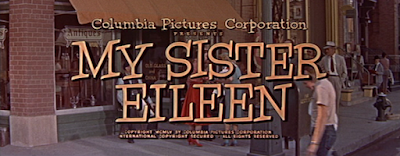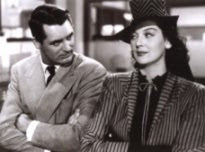Judy & Jack, together (too infrequently)
During his five-decade film career, Jack Lemmon pretty much varied his co-stars, particularly his leading ladies. But he managed to appear with Kim Novak in three titles ("Phffft!," "Bell, Book and Candle" and "The Notorious Landlady") and he made two movies each with Shirley MacLaine ("The Apartment" and "Irma La Douce"), Lee Remick ("Days of Wine and Roses" and "Tribute"), Dorothy Provine ("Good Neighbor Sam" and "The Great Race"), Sally Kellerman ("The April Fools" and "That's Life") and best of all - drum roll, please! - the inimitable, the one-and-only Judy Holliday.Judy and Jack made two films - George Cukor's "It Should Happen to You" and Mark Robson's "Phffft!" - that were released back-to-back in 1954, although they weren't made consecutively (more about that later). And they almost made a third (and more about that later, too). Jack often remarked that he felt blessed that, for his film debut in "It Should Happen to You," he was paired with Judy Holliday who, during the 1950s, was the darling of Columbia Pictures, where Lemmon was a new contract player.
Surprisingly, Holliday, who died of breast cancer way too young (age 44) in 1965, had substantial roles in only eight major films (with bits in four others). Her movie career is bookended by two Metro titles - George Cukor's "Adam's Rib" (1949) and Vincente Minnelli's film musical, "Bells Are Ringing" (1960), an adaptation of her Comden-Green Broadway hit.
In-between, she appeared in six titles at Columbia, beginning with her Oscar-winning "Born Yesterday," also directed by Cukor and also an adaptation of one of her stage successes. The other titles were two more by Cukor, "The Marrying Kind" (1952) and "It Should Happen to You," "Phffft!" and two made with Richard Quine, "The Solid Gold Cadillac" and "Full of Life" (both released in 1956), after which Holliday left Columbia to return to Broadway for a run in the aforementioned "Bells Are Ringing."
All of Holliday's Columbia titles were filmed in black-&-white (with the exception of the final scene in "The Solid Gold Cadillac," a novelty showing the title car in glimmering gold). "Bells" was her only full color movie.
OK, I have to stop here and ask Sony Home Entertainment: Where the heck is a boxed DVD set of Judy's six Columbia titles? It's long overdue.
That said, back to the topic... "It Should Happen to You," based on an original screenplay written by Garson Kanin (under the working title, "A Name for Herself"), is a rather prescient - and very witty - tale of a New York model and wannabe celebrity named Gladys Glover (Holliday) who hatches a clever scheme to make a name for herself by renting a huge Columbus Circle billboard and having her name emblazoned across it:
Gladys Glover.
Gladys Glover. That's all. Just her name. But it's enough to prompt curiosity and a buzz around Manhattan. Who - or what - is Gladys Glover?
"It's Glover! Not a C, like you got it - G, like you haven't got it!" -Judy Holliday as the incorrigible Gladys
Gladys' eccentricity isn't enough to initially deter the ardor of a struggling documentary filmmaker, Pete Sheppard (Lemmon), who shrewdly finds a way to move into the apartment building where Gladys lives. As her signs around New York multiply, Gladys' modeling career is kicked into high gear. But she becomes a joke - the symbol of nothing, a dubious distinction that she seems to relish.
She's living a fraudulent life. And Pete simply can't compete with - or stomach - her growing obsession with empty fame. It's become disruptive.
This makes for a cautionary tale but one that, thanks to Holiday's flawless timing and inimitable line readings, is hands-down hilarious.
As for Lemmon, he makes an auspicious, pleasing screen debut and, for once, the display ads introducing him as "a guy you're gonna like" are spot-on accurate.
The next film that Lemmon filmed was H.C. Potter's "Three for the Show," one of those irresistible piffles about someone who ends up, inadvertently, with two spouses. Officially, Potter's film is a remake of Wesley Ruggles' 1940 film with Jean Arthur, "Too Many Husbands." Betty Grable has the Arthur role here, with Jack and Gower Champion as her husbands.
You've also seen this before, of course, in Garson Kanin's 1940 "My Favorite Wife" (with Cary Grant and Irene Dunne) and Michael Gordon's 1965 remake, "Move Over, Darling" (with Doris Day and Jame Garner).
The release of "Three for the Show" was held up and delayed until 1955 while Columbia dealt with the Catholic Church's Legion of Decency, which slapped the film with its notorious "Condemned" rating because, according to the Legion, it encouraged adultery. Consequently, Lemmon's third film, "Phffft!," was released as his second - this one a comedy about divorce.
But it had no censorship problems.
 Nevertheless, both films have one
thing in common - uncommonly smart, alert scripts written by people who
honed their skills on the stage. Axelrod - the author of the scripts for "The Seven
Year Itch," "Breakfast at Tiffany's" and "The Manchurian Candidate" and the director of "Lord Love
a Duck" - came up with sharp, ageless observations as he investigates
the disintegration of the marriage of Nina and Robert Tracy (played by Holliday and Lemmon) and the way it inevitably rebounds.
Nevertheless, both films have one
thing in common - uncommonly smart, alert scripts written by people who
honed their skills on the stage. Axelrod - the author of the scripts for "The Seven
Year Itch," "Breakfast at Tiffany's" and "The Manchurian Candidate" and the director of "Lord Love
a Duck" - came up with sharp, ageless observations as he investigates
the disintegration of the marriage of Nina and Robert Tracy (played by Holliday and Lemmon) and the way it inevitably rebounds."Phffft!" could be called post-trendy.
Axelrod's dialogue is a particular treat. That invaluable character actor,
Jack Carson, plays Charlie Anderson, Lemmon's best friend - a confirmed bachelor who forever hands out both bad and interesting dating advice. His lecture on the allure of facial hair provides an excellent case in point:
Charlie (to Robert): "Grow a moustache. A moustache is very important, It's all part of the famous Charlie Anderson Theory on the Efficacy of Face Hair in Dealing with the Opposite Sex. Sure. Always remember this, Bobby -- dames become unpredictable when faced with a moustache -- it both arouses and angers them -- Being as it is a symbol of masculinity, they feel drawn toward it."
At this point, the camera shifts to Lemmon's reaction and the remainder of Carson's pontification as scripted by Axelrod is deleted from the release print: "And at the same time, because of envy, they feel impelled to
cause its removal. All men should raise moustaches from time to time."
Then there's the very funny dance sequence. Both the Lemmon and Holliday characters take
dance lessons (independent of each other) at an Arthur Murray's, only to unexpectedly end up together in the next
scene on the dance floor of a nightclub, doing a wickedly hilarous
mambo (choreographed by an uncredited Jack Cole, who also designed the
dances for "Three for the Show") - a movie moment every bit as
memorable, and as witty, as anything in a Billy Wilder film.
By the way, Axelrod's full, original title for the film was "Phffft: Chronicle of a Happy Divorce."
The movie that Lemmon and Holliday almost made was Richard Quine's "My Sister Eileen" (1955), a wonderful film musical, thanks largely to a pleasing Jule Styne-Leo Robin score, early Bob Fosse choreography (before it became terminally mannered) and a smashing lead performance by Betty Garrett as Ruth Sherwood, her only real lead role in a film.
Garrett had inherited the role of Ruth when Holliday had to back out at the last minute. Janet Leigh is charming as her sister Eileen (and also dances well with Fosse) and Jack, in a largely supporting role, has fun with his giddily salacious number (pictured below), "Bigger Than Both of Us."
Director Quine started out as an actor and appeared in 25 titles, including Rosalind Russell's original "My Sister Eileen" film (1942), in which he played soda jerk Frank Lippincott, the young man nursing a crush on Janet Blair's Eileen. Thirteen years later, he would direct this film, with the role of Lippincott going to Fosse (billed here as Robert Fosse, incidentally). One can only imagine what Holliday would have been like in the role of Ruth, but frankly, I can't imagine "My Sister Eileen" without Betty Garrett. She's the film's heart, first-rate, plus her chemistry with Lemmon is grown-up, smart and sublime.
Notes in Passing: Lemmon made a fourth film with Kim Novak - George Sidney's "Pepe" of 1960 - but they never appeared together on screen. Each had their own brief vignette with star Cantinflas. Also Garson Kanin's script for "It Should Happen to You" (with "A Name for Herself" on the cover page) is available for review at Lincoln Center's library in New York.















































